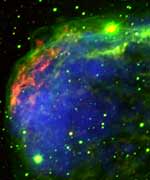
Image credit: Chandra
A new composite/optical image taken by the Chandra X-Ray Observatory shows a portion of the Crescent Nebula, a gaseous shell surrounding the massive star HD 192163. Early on in its life, the massive star expanded to become a red giant, and then compacted down again and began emitting an intense stellar wind that pushed material away at 4.8 million kph. We see the nebula from Earth because the wind is heating up the shell of material the star left when it was a red giant. The massive star is only 4.5 million years old, but it?s already nearing death; astronomers believe it will explode as a supernova within 100,000 years.
Massive stars lead short, spectacular lives. This composite X-ray(blue)/optical (red and green) image reveals dramatic details of a portion of the Crescent Nebula, a giant gaseous shell created by powerful winds blowing from the massive star HD 192163 (a.k.a. WR 136).
After only 4.5 million years (one-thousandth the age of the Sun), HD 192163 began its headlong rush toward a supernova catastrophe. First it expanded enormously to become a red giant and ejected its outer layers at about 20,000 miles per hour. Two hundred thousand years later ? a blink of the eye in the life of a normal star ? the intense radiation from the exposed hot, inner layer of the star began pushing gas away at speeds in excess of 3 million miles per hour!
When this high speed “stellar wind” rammed into the slower red giant wind, a dense shell was formed. In the image, a portion of the shell is shown in red. The force of the collision created two shock waves: one that moved outward from the dense shell to create the green filamentary structure, and one that moved inward to produce a bubble of million degree Celsius X-ray emitting gas (blue). The brightest X-ray emission is near the densest part of the compressed shell of gas, indicating that the hot gas is evaporating matter from the shell.
HD 192163 will likely explode as a supernova in about a hundred thousand years. This image enables astronomers to determine the mass, energy, and composition of the gaseous shell around this pre-supernova star. An understanding of such environments provides important data for interpreting observations of supernovas and their remnants.
Original Source: Chandra News Release
